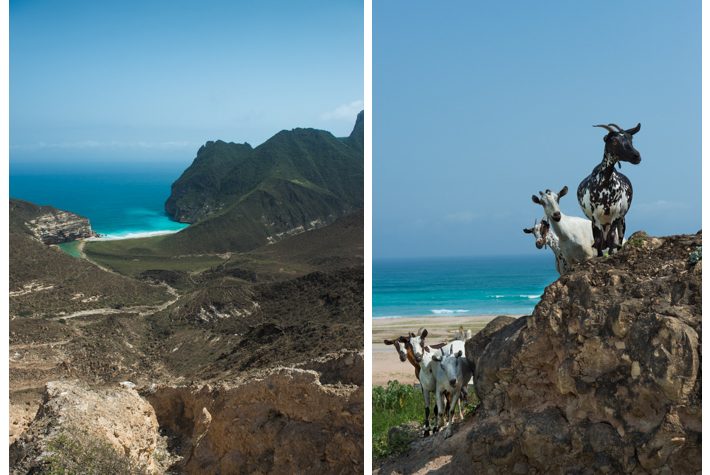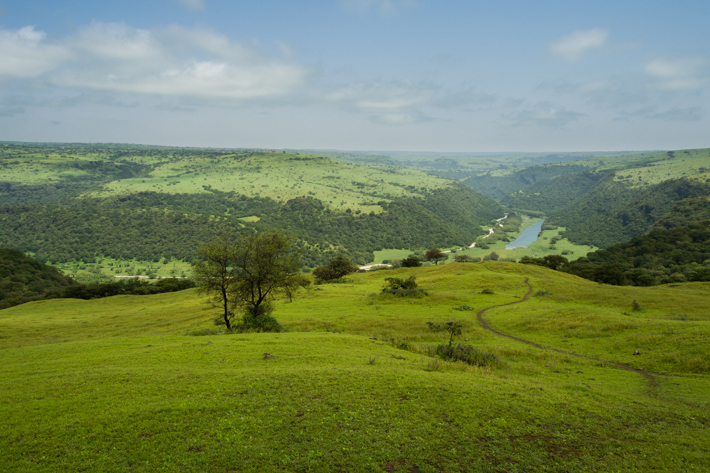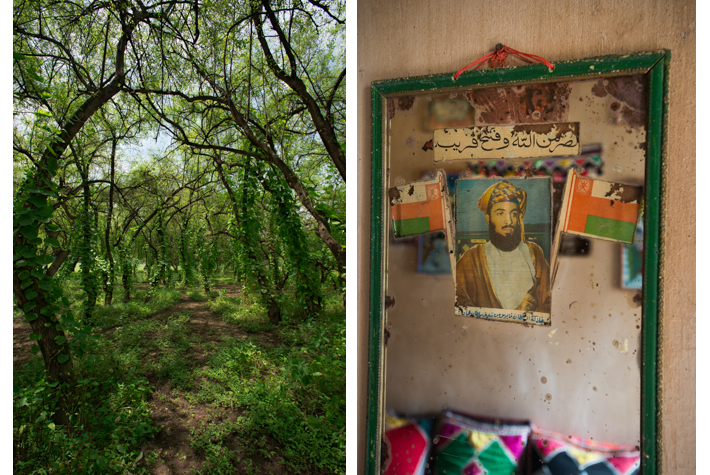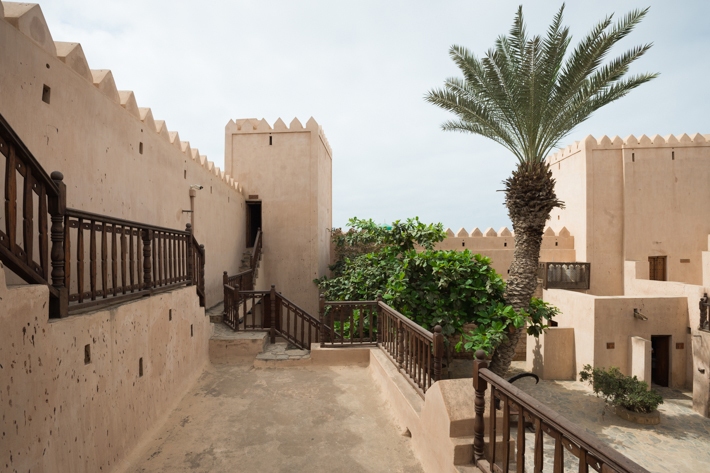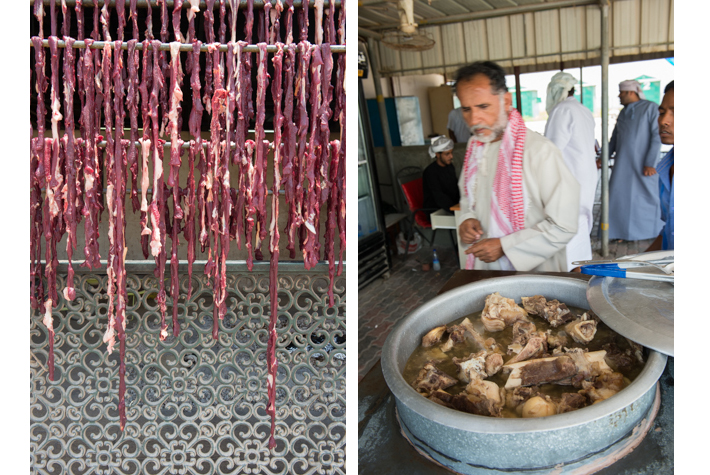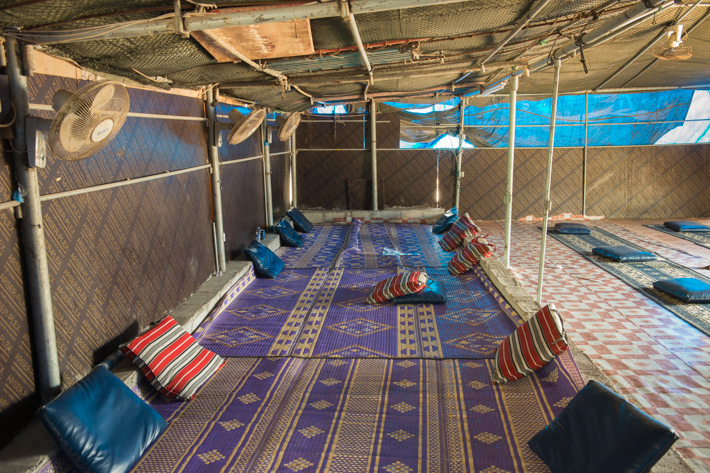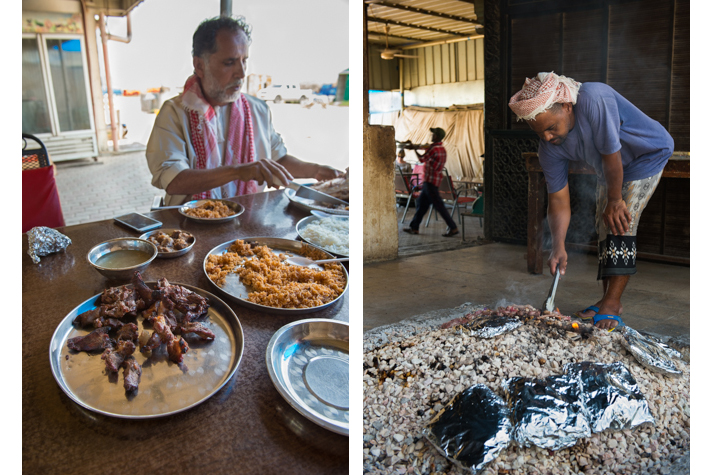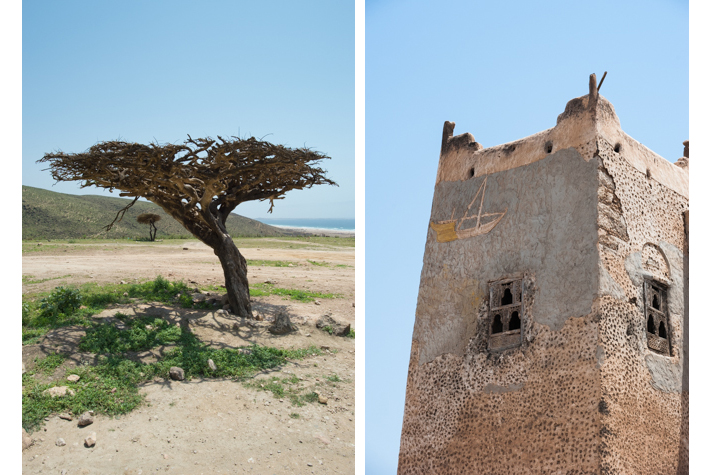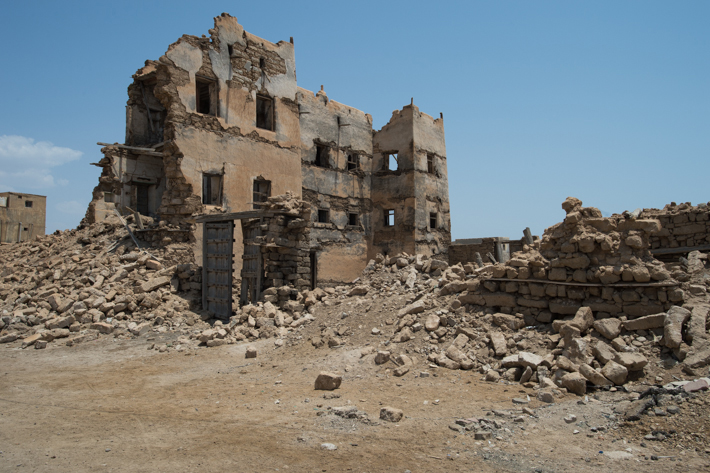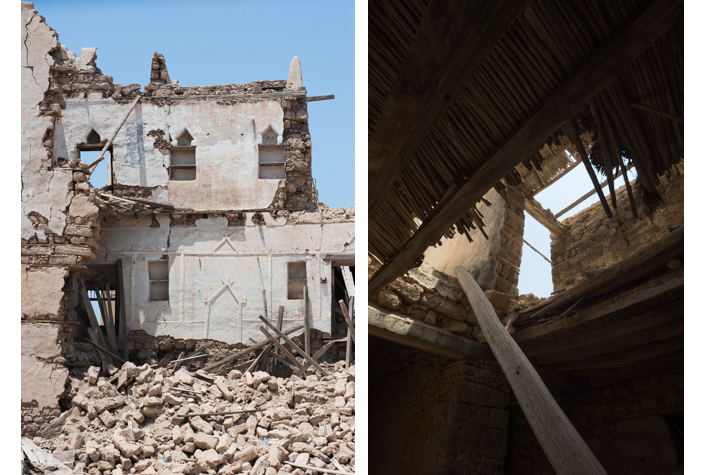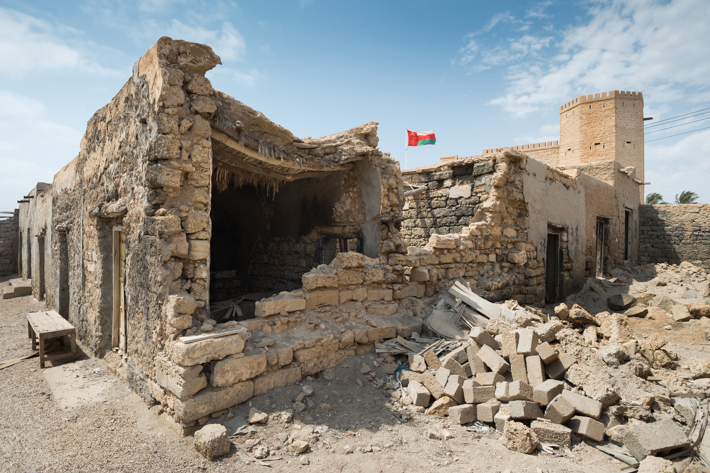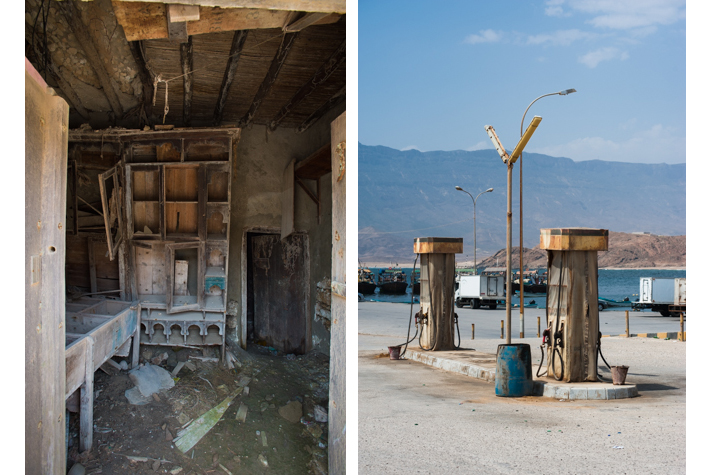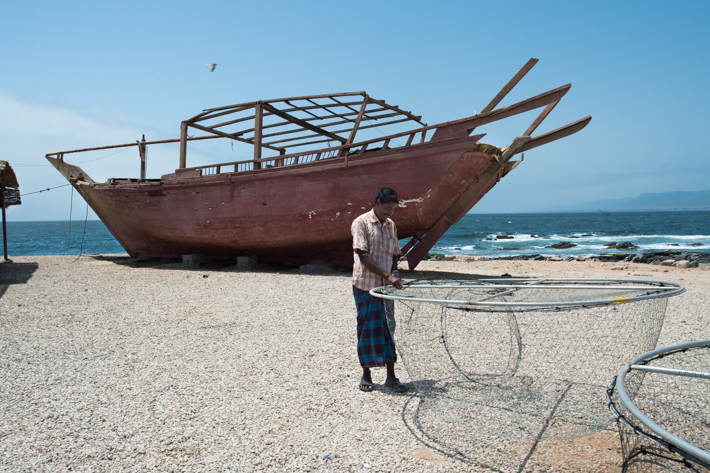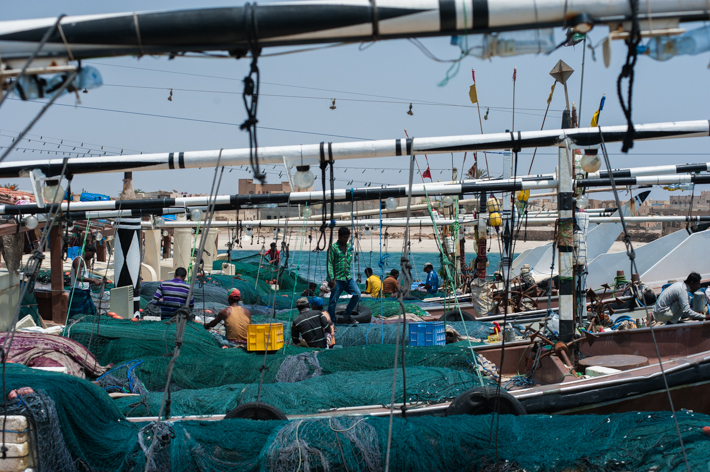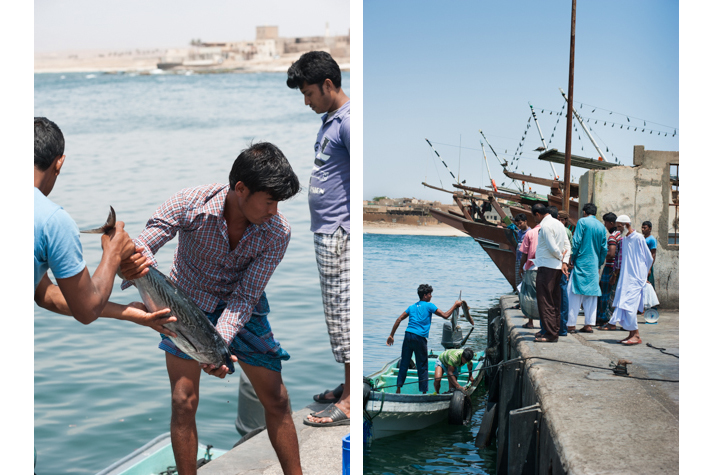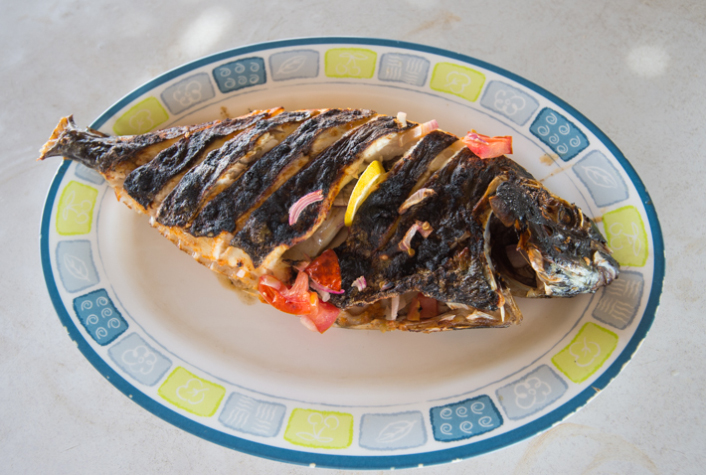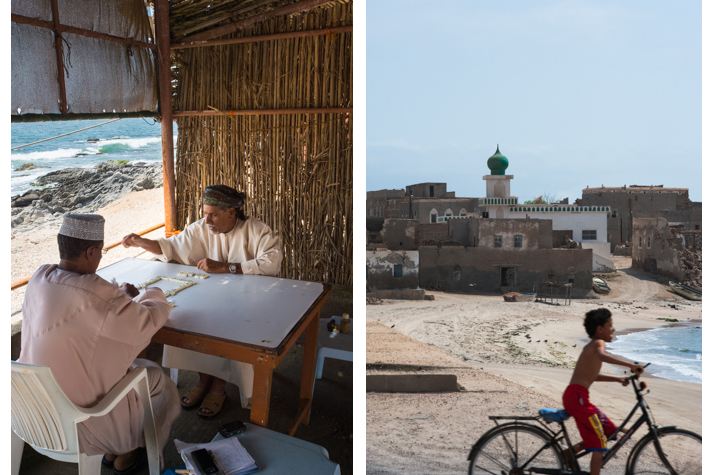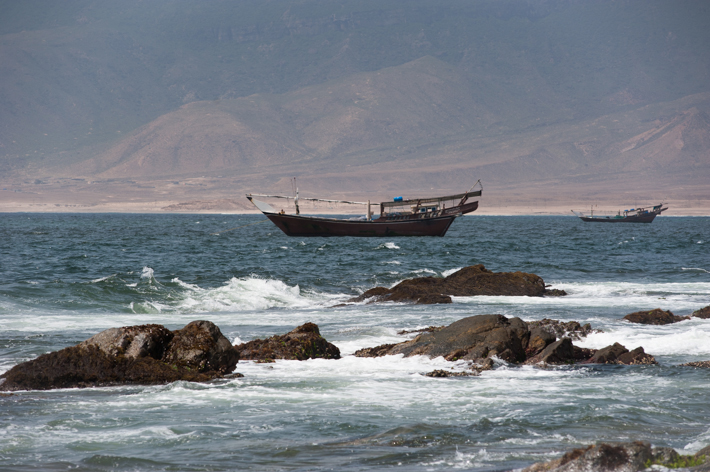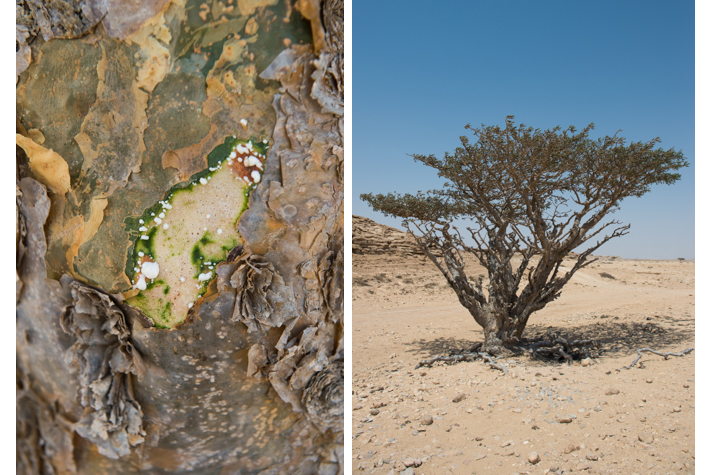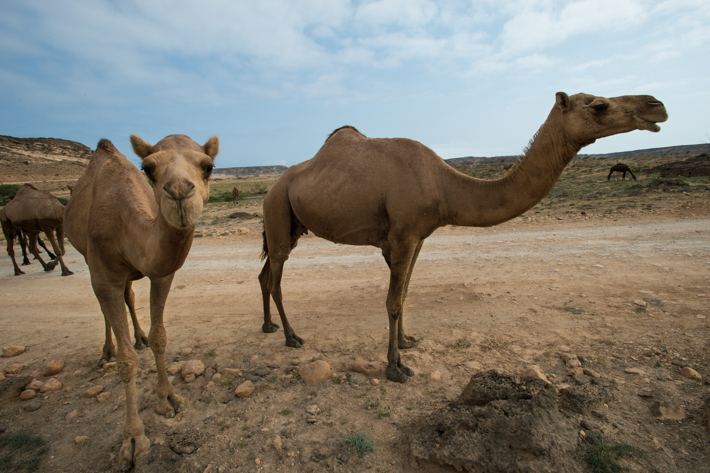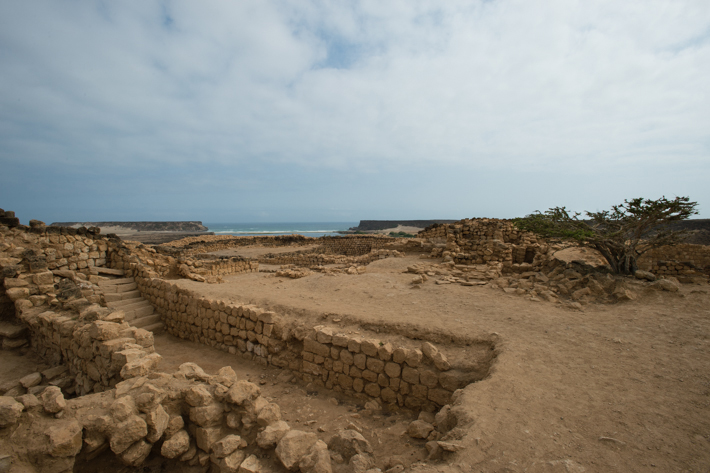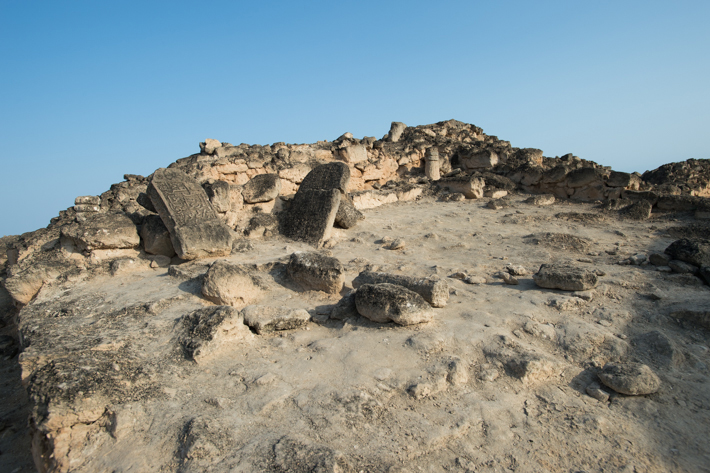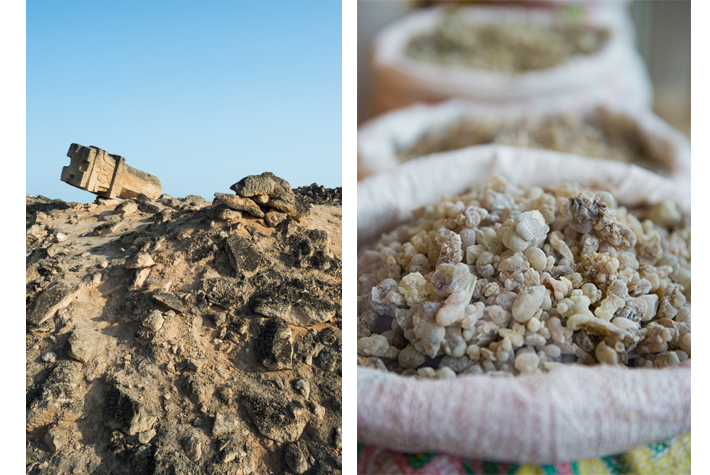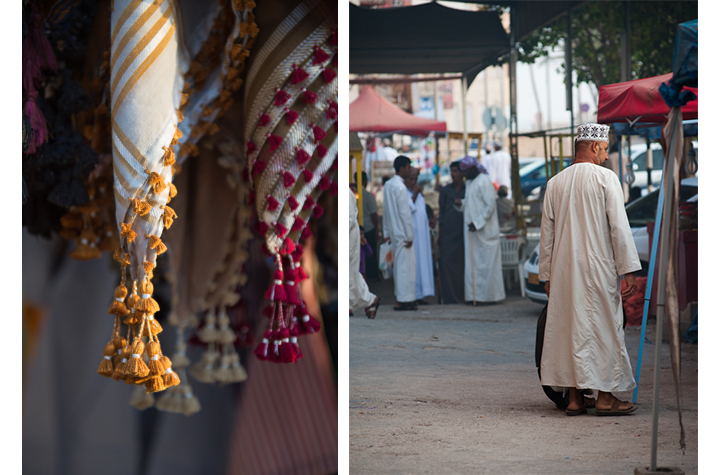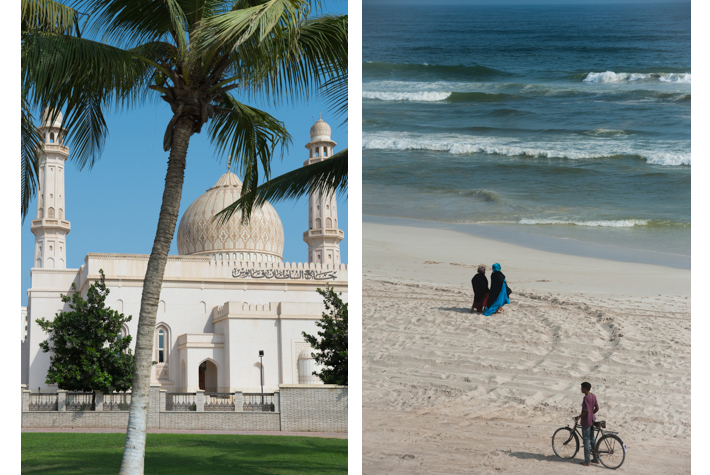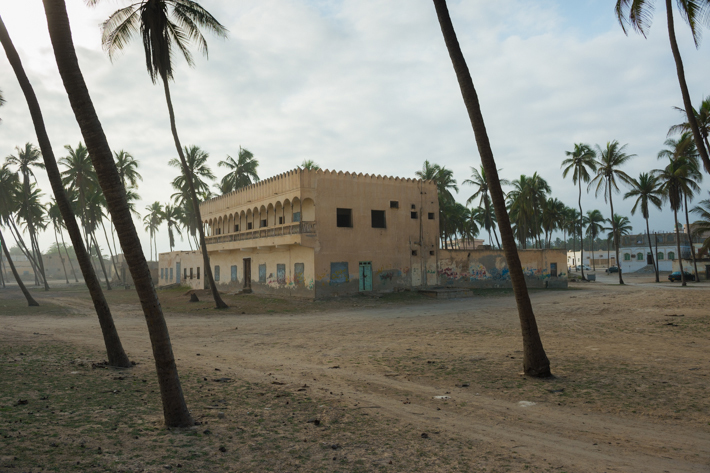Visiting the Queen of Sheba
A guide to Oman's exquisite, remote south
There is a region
of the Arabian Peninsula that is so lush and green it might be Ireland.
As we’re driven along unmade roads through an undulating landscape of rich pasture, dotted with happily munching cows and wild fig trees, any thought of Lawrence riding a camel in the arid sand dunes of Arabia is the furthest thing from my mind.
And yet there are camels. Tens of thousands of them, eating grass and gnarly bushes on the plains below the mountains, wandering on the roads, loping on the white sand beaches of the Arabian Sea.
This is the countryside around Salalah, in Oman’s southern Dhofar region, a distance of 1040 km from the country’s capital, Muscat, and the place where many residents of the Gulf States escape during the punishing summer for cooler temperatures and welcome rain.
Salalah is blessed with a khareef, or monsoon, from July to early September, when moisture over the cooler waters of the Indian Ocean condenses into heavy fogs that replenish the grasses and plants of the mountains. These coastal mists are such a cause for celebration, Salalah holds an annual cultural and sporting festival during the wetter months.
We’re visiting in mid-September, just as the monsoon concludes, and it’s humid but sunny. Our guide Musallem explains that we’ve been lucky – in the weeks before, it has been so foggy it was impossible to see much of anything. The humidity delights the Arabs, but European visitors tend to come in the dry months October-May, when it’s cool in the north of Europe but Salalah’s temperatures hover perfectly around 27 degrees Celsius.
Much of the nation, with its beautiful old forts and charming white-washed houses, appears very much how it was centuries ago.
Salalah’s lushness is only one surprise in a country that thwarts expectations. Oman is a progressive country, with enshrined human rights, that was until recently ruled by an enlightened, British-educated Sultan, His Majesty Qaboos, who was responsible for transforming one of the poorest countries in the region into one with a high standard of living, without sacrificing authenticity. Qaboos died in 2019 and the new Sultan, His Majesty Haitham bin Tariq Al Said, is expected to rule in a similarly progressive fashion.
Unlike its neighbour, the United Arab Emirates, which were formed in the 1970s around the same time Qaboos became Sultan in 1970, there are few high-rises in the country and much of the nation, with its beautiful old forts and charming white-washed houses, appears very much how it was centuries ago, except for impressive national infrastructure works, including roads, schools, hospitals and universities.
Omani culture has not been sacrificed to economic development and the modest, softly-spoken Omanis still dress in traditional white dishdashas, or long robes, and abayas, the black robes women wear, and, beyond the cities, many still practice a feudal way of life, keeping herds of goats and camels and earning sustenance from fishing.
Our guide, Musallem, who is about sixty I guess, tells us he was born in a cave to a nomadic family, one of ten children, and looked after the goats at six years old. He walked to school 6 km each way every day to school. Later, he became one of the first tourist guides in Salalah as the country opened up, and now owns a funky little bed & breakfast, Arabian Sea Villas, on the beach near the centre of the city. Like most Omanis, he’s well educated, and his life has been improved by the county’s advances, although he laments some changes.
It’s dark when Musallem picks us up from Salalah airport (the new airport has just opened) and we almost hit a young camel which is wandering outside our hotel, the Juweira Boutique Hotel, part of a new marina complex that will eventually include five hotels, boutiques and a golf course, the sign of Dubai-style development to come. ‘This was the camel’s favourite place,’ Musallem says. ‘And they still come here.’
‘Fifty years ago, if someone had one hundred camels he is like a millionaire. He would be respected, very famous, every girl wanted to marry him. Today’s girls don’t want to marry a camel farmer. Everyone wants a luxury life – nice car, nice clothing. The camel farmers are sad because they’ve lost their position.’ Musallem explains that the camel farmers ‘love their camels’ and care for them ‘like babies.’ But they spend more on raising the animals than they make when they sell them to be slaughtered. (Selling the camels they adore also makes the farmers ‘sad.’)
During the khareef the camels come down from the mountains to graze by the sea and to avoid being bitten by summer’s nasty black flies. Some of them are fed sardines and their milk is an acquired taste, Musallem admits.
Camel meat is a local delicacy and eaten in great amounts, judging by the food stalls along ‘local restaurant road’.
Travelling along the spanking new highways, you’re still likely to have to stop occasionally for wandering camels or herds of goats. On one occasion we pass a goat herder sitting on the grass verge with his arm around a goat, affectionately.
Camel meat is a local delicacy and eaten in great amounts, judging by the food stalls along ‘local restaurant road’, a strip of mostly barren land lined with ten tented restaurants that serve camel meat several ways – smoked, grilled on an open fire, boiled on the bone, stewed in its own fat or in a chilli sauce. Like everything down here, the meat of the grass-fed, pampered camels is a surprise: it’s tender, delicious, delicately flavoured like spring lamb.
It’s probably not surprising that this exotic, faraway land is still very much undiscovered by tourists from our part of the world. Musallem tells us we’re only the second Australian couple he’s met in his years of guiding. But with so many Australians now travelling to Europe via Dubai and Abu Dhabi, a few are taking the opportunity to fly into Muscat for fascinating sidetrip. It’s a destination in it’s own right, though.
While I think Muscat is one of the most beautiful cities in the world, I think the Dhofar region is unmissable too, for its spectacular landscapes, long white beaches, diverse scenery and fascinating culture. It’s only a short flight from Muscat or directly from Dubai. And I’ve never felt safer anywhere, although we’re only a couple of hundred kilometres from the Yemen border. Oman is a peaceful country and most Omanis practice a tolerant and inclusive form of Islam, Ibadism.
Walking around Salalah’s famous Frankincense Souq, where the aromatic resin, for centuries the region’s richest export, is sold in big burlap sacks, I’m greeted by stall holders calling out ‘welcome,’ plying me with heavily fragrant oils and incense, and offering the tasselled scarves that men wear as turbans in this region. But when I smile and firmly say no, they all back off graciously. One evening, I am the only foreign woman in this souq, and yet I wander around alone, feeling totally accepted.
I am also the only woman at the outdoor café next door to the souq. Sitting around and drinking tea seems to be a man’s thing to do. This is a country that is proud of its women’s achievements, including becoming doctors and pilots, but the traditions of Arabic culture, including veils (although less commonly burqas) are observed. In the new and impressive Land of Frankincense Museum there’s a section devoted to Oman’s universities and schools, which features a large colour photograph of a graduating class of about a hundred women.
The next day, touring with Musallem’s son Mohammed, we travel into the green mountains, to visit a wadi, or riverbed, which runs with the clearest aquamarine water. Later, we emerge from the mountains at a point overlooking the ocean near Mirbat, a city that once was the epicentre of the frankincense trade, which was the main source of Dhofar’s economy for over 2000 years. It was shipped as far as Europe via Africa and the Mediterranean and to China along the silk route. The value of frankincense has declined over the centuries, and now the Roman Catholic Church, Oman’s greatest customer in early times, buys the resin from Somalia, where the product is inferior, but cheaper.
Nothing prepares me for Mirbat. It’s still a fishing village and guest workers from places such as Bangladesh and India live there because it’s cheap. But a great part of the city has been left to crumble into ruins. Once-handsome merchant’s houses, mostly dating from the 19th Century still stand, but are reduced internally to rubble, open to anyone who wants to wander through them and pick through the rubbish. Beautiful old carved doors hang off their hinges, faded in the sun, and shop counters in the old souq stand dusty and bare of goods.
The legendary Queen of Sheba, who some believe ruled this region in the 10th Century BC, is said to have built her summer palace here.
It’s breezy along the beach, where the white sand is scattered with fishing nets and the hulls of old dhows, the traditional fishing boats. Giant turtles pop up their heads as they dive for fish in the shallows. We stop at a beachside restaurant, not much more than a shack, where we feast cheaply on blackened whole fish, salads and two kinds of rice. At the next table, two men play dominoes. One man has a peg on his ear. When we ask why, we’re told that each time a player loses he has to wear a peg. The man is wearing three pegs by the time we leave.
UNESCO has four world heritage sites relating to frankincense in Dhofar, including a plantation of 5000 trees in the rocky desert at Wadi Dawkah, just beyond the green mountains. The trees are endangered through a combination of over exploitation and climate change. In commercial plantations in the region, the sap is tapped by the bark being stripped repeatedly in places, leaving the sap to form droplets, which are then collected and dried.
Rising up on a high point overlooking an inlet and the cliff-fringed coast is another UNESCO site, the magnificent architectural site of Sumhuram, a city that dates back to the 2nd Century BC as a port for the shipment and dry storage of frankincense. It’s the first architectural site I’ve visited recently that barely has any tourists climbing over it. The legendary Queen of Sheba, who some believe ruled this region in the 10th Century BC, is said to have built her summer palace here.
Closer to Salalah, the settlement of Al-Baleed, which dates back to 2000 BC, and which covers an area of 64 hectares, is another UNESCO protected site. Most of these architectural treasures are undergoing restoration with the assistance of various missions, including Americans, Germans and Italians. All the architectural sites are looking pretty good for their age and would delight anyone who loves messing about in ruins.
What is most striking about the landscape around Salalah is its variety, from the long beaches that stretch hundreds of kilometres along the clear Indian Ocean, to craggy mountain ranges, green rolling hills, rocky deserts, and beyond those, the formidable sand dunes of the Arabian Empty Quarter. South of Salalah towards Yemen, the deserted beaches stretch forever and form into gorgeous coves overlooked by rocky outcrops with spectacular blowholes. We notice empty seaside houses here, bestowed on locals by the government, we are told. Why are they empty? The nomadic people prefer living in the valleys, Musallem says.
Salalah itself might be Sri Lanka with its plantations of coconut and banana and fruit stalls selling tropical produce that flank the highway into town. The city’s Corniche, or beachside road, is lined with cafes and dozens of abandoned buildings, waiting to be demolished for new hotel developments. An Anantara resort, Al Baleed, is scheduled to open soon.
Right now, friendly and laid back Salalah feels like the last authentic outpost on earth. But there are signs that development is on the way. The infrastructure of new roads and public works is amazing and there’s the huge hotel complex on the marina. Oman has been smart about the way it has preserved its heritage and it’s unlikely Salalah will ever turn into Dubai. But it’s inevitable this wonderful place will be discovered in a big way, especially when the new airport opens.
Go soon, just in case.
GETTING THERE
Oman Air has frequent daily services from Muscat to Salalah and once a week direct service from Dubai. Oman Air flies daily into Kuala Lumpur, twice daily into Bangkok, three times a week into Manila and four times a week into Jakarta, connecting to Australia with the airline’s partners.
STAYING THERE
The 82-room Juweira Boutique Hotel marina-front hotel is part of a complex on 16 million square metres that will soon house five hotels, villas, shops and a golf course. Set across the marina from a beautiful and mostly empty beach, this lifestyle hotel is on the large side, but the ebst place to stay before the Anantara Resort opened in
The Al Baleed Resort Salalah by Anantara opened in 2018 and changed the game in Salalah. We haven’t stayed there yet, but we love Anantara’s Qasr al Sarab in the UAE so we expect this 136-room and villa hotel on a 250-metre stretch of beachfront to be similarly luxurious.
FIVE THINGS TO DO IN SALALAH
EAT CAMEL MEAT
Ask your guide or a taxi to take you to the outskirts of town to the ‘local restaurants’. Buy a big hunk of boiled bone or a cut of grilled meat. It’s very basic (and cheap) but the dishes are delicious. The restaurants are certified authentic.
LEARN ABOUT THE LAND OF FRANKINCENSE
This cool and inviting museum covers the history of Oman and the frankincense trade. A separate room houses marvellous models of traditional sailing ships. The Al-Baleed architectural park is right next door.
SHOP IN THE SOUQ
This large but manageable souq with friendly shopkeepers is a real treat with authentic goods for sale. (Check that turban scarves or mussar and pottery incense burners are made locally.) Have a kuma, or Oman man’s cap, tailored to fit your head or buy sacks of frankincense in four different grades. (The pale green is the most prized.
VISIT THE SULTAN QABOOS MOSQUE
Sultan Qaboos was born in Salalah and this beautiful new mosque celebrates his connection to the people of this region. A larger mosque is one of the main attractions of the capital Muscat.
CELEBRATE THE KHAREEF
Held during the three months of the monsoon from June to September, the Salalah Tourism Festival features cultural attractions, concerts, sporting events and shopping promotions and attracts many visitors from the hotter Gulf States.
Mr and Mrs Amos were guests of Oman Tourism and Oman Air.

